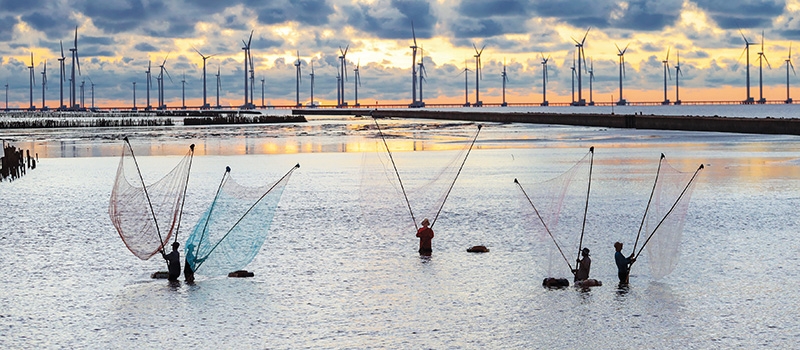Green growth strategy receives helping hand
 |
| Green growth strategy receives helping hand |
Clean energy is one of the focal points that the international community is encouraging Vietnam to implement in its National Green Growth Strategy for the 2021-2030 period, with a vision to 2050, and representatives of embassies and international organisations at the consultative conference organised by the Ministry of Planning and Investment (MPI) last week discussed opinions for this strategy.
Emphasing the importance of clean energy in the green growth process, British Ambassador to Vietnam Gareth Ward said, “This consultation is useful because Vietnam will be recovering faster from the pandemic than most countries and there’s a lot of supply chain relocation into Vietnam happening, which also means a lot of opportunities to do things differently. So, we very much welcome the national green growth strategy.”
Energy is a sector requiring great attention as it is also the major source of greenhouse gas (GHG) emissions.
“Vietnam has a very large potential in wind and solar, and the country could be much quicker in establishing a stable supply in time. I think there should be a particular focus in the strategy on attracting public investment into the grid’s resilience for renewable energy,” Ward said.
“Some international investors have expressed their interest to invest in the green energy sector,” he added. “So, green finance is a sector that Vietnam can develop with green bonds and investment funds, while simultaneously setting standards that will change the calculations of the banking system,” he added.
Ambassador of Spain to Vietnam María del Pilar Méndez Jiménez said, “I would encourage Vietnam very much to develop green energy because we are aware of how important energy, solar wind and water are. There are also Spanish companies that are willing to cooperate with Vietnam in this regard.”
The Politburo’s Resolution No.55-NQ/TW dated October 2, 2020 on the orientation of Vietnam’s National Energy Development Strategy until 2030 and outlook to 2045 already points towards cleaner and greener energy. The resolution states that renewable energy sources in the primary energy mix should sit somewhere between 15-20 per cent by 2030 and 25-30 per cent by 2045. The government also targets to reduce GHG emissions from energy activities by 15 and 20 per cent by 2030 and 2045, respectively.
A McKinsey study shows Vietnam has tremendous natural endowments, yet the country’s market for renewables remains in its infancy, with a grid scale of only about 200MW from solar and wind online.
“A successful renewables-led pathway includes building out the country’s wind and solar generation capabilities to 39GW and 61GW by 2030, respectively,” the study stated. “This would be five times more than Vietnam’s current energy plan and would need to be supplemented by natural gas and battery storage.”
International organisations have been working to help Vietnam promote energy. The GIZ Energy Support Programme is supporting the Vietnamese government in developing renewables by addressing barriers. GIZ works on several levels with the Ministry of Industry and Trade’s Electricity Regulatory Authority of Vietnam and other institutions to implement aspects of Vietnamese policies.
Along with the importance of energy development in realising the national green growth strategy, onlookers have pointed out there that shortcomings remain. British Ambassador Ward said, “All countries that are setting their targets not only need to look at growing renewables, they also need to look at the way to phase out coal and other brown energy sources.”
Though highly valuing the green growth strategy, Dong-bae Kim, Economic Minister-Counsellor of the South Korean Embassy in Hanoi also raised concerns over how it relates to the National Power Development Plan 8, especially in the power generation.
What the stars mean:
★ Poor ★ ★ Promising ★★★ Good ★★★★ Very good ★★★★★ Exceptional
Themes: Sustainable Energy
- 16th national conference on nuclear science and technology opens in Danang
- Technology and Energy Forum 2023 to open in Quang Ninh
- Asia Clean Capital Vietnam receives backing from Swiss Investment Manager
- Amazon scales renewable energy to fight climate change
- Universal Alloy Corporation Vietnam partners with Asia Clean Capital Vietnam
Related Contents
Latest News
More News
- TCP Group partner with VNUS to launch water conservation project (December 25, 2025 | 14:00)
- Heavy industries set for pilot greenhouse gas quotas (December 25, 2025 | 10:00)
- Swedfund invests in MSME growth and climate action in Vietnam (December 19, 2025 | 11:42)
- GreenYellow brings solar energy to light up remote schools in Tuyen Quang province (December 19, 2025 | 08:00)
- Charge+, Grab partner to develop EV charging network in Vietnam (December 18, 2025 | 17:11)
- Linking sci-tech and innovation to Vietnam’s net-zero future (December 18, 2025 | 14:31)
- Driving double-digit growth through green and circular transformation in Vietnam (December 17, 2025 | 09:00)
- Standard Chartered and ACCA deepen collaboration to develop Vietnam’s talent for a sustainable future (December 15, 2025 | 18:18)
- Schaeffler reports strong early output from Dong Nai solar project (December 12, 2025 | 15:16)
- Forestry conference highlights biodiversity and sustainability goals (December 09, 2025 | 13:35)

 Tag:
Tag:




















 Mobile Version
Mobile Version